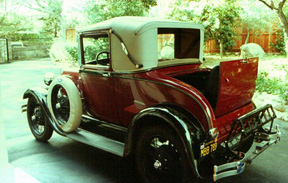| This is my 1929 Ford Sport Coupe
that I have owned for more than 50 years. It's a rare Dual Side Mount Deluxe
Model. I did a ground up restoration of this car in 1955 when I was 16
years old. This taught me all the basics of automobile mechanics, and launched
a lifelong love of cars.

Every part was disassembled, cleaned,
painted, and reassembled with even more care than when it rolled off the
assembly line 26 years before. It has a hand rubbed lacquer job with so
many coats it will never need painting again.
It was completed during the summer
of '56, and I switched off driving it and my '51 Ford Convertible
to high School. The '51 is another story, and it's the only "keeper" I
didn't' keep.
The photos above were taken recently
and the one to the right in 1956 showing that the car still looks exactly
the way it did when I completed it 52 years ago. Only the rumble seat passenger
looks slightly different now. I drive it around Santa Barbara on the weekends.

Santa
Barbara's Historic Granada Theater
First
Opened in 1924, And Again In 2008 After A $50,000,000.00 Remodel
My
Model 'A' Was There To Celebrate
|